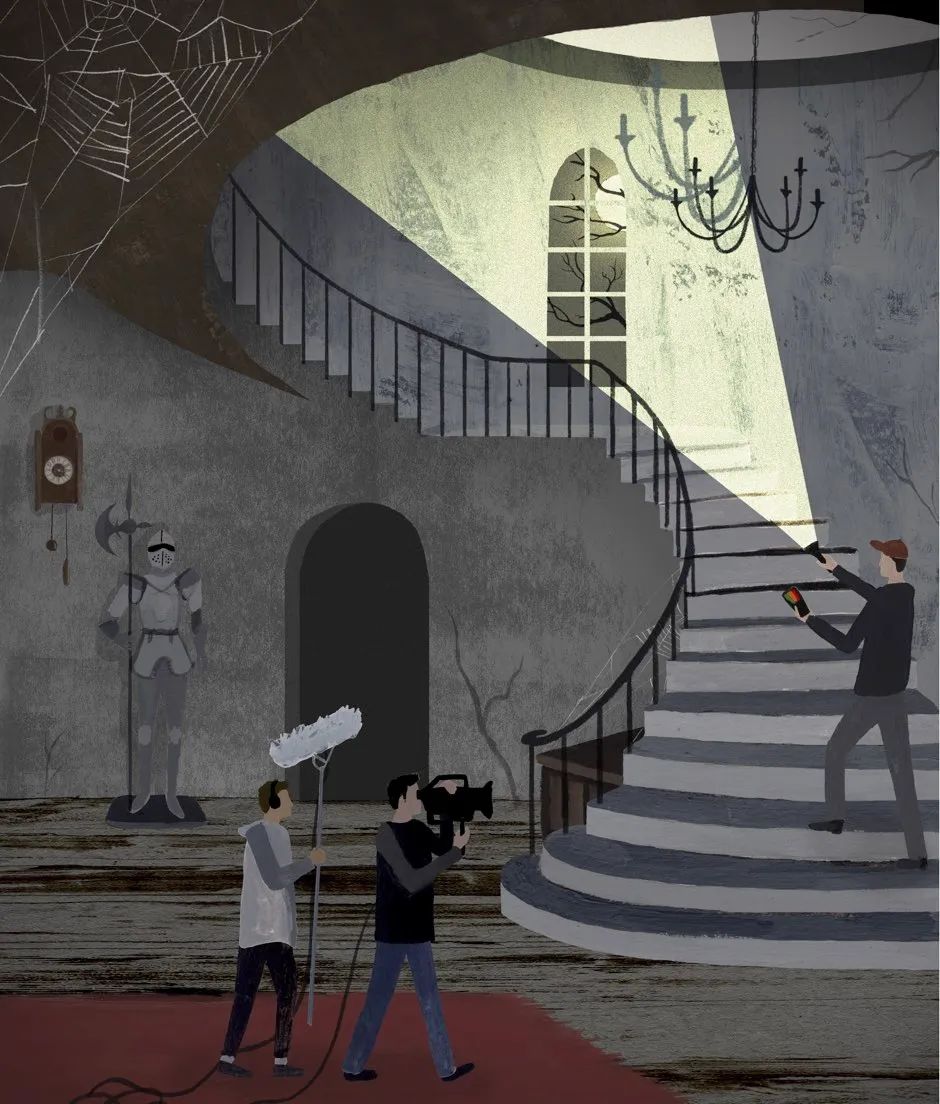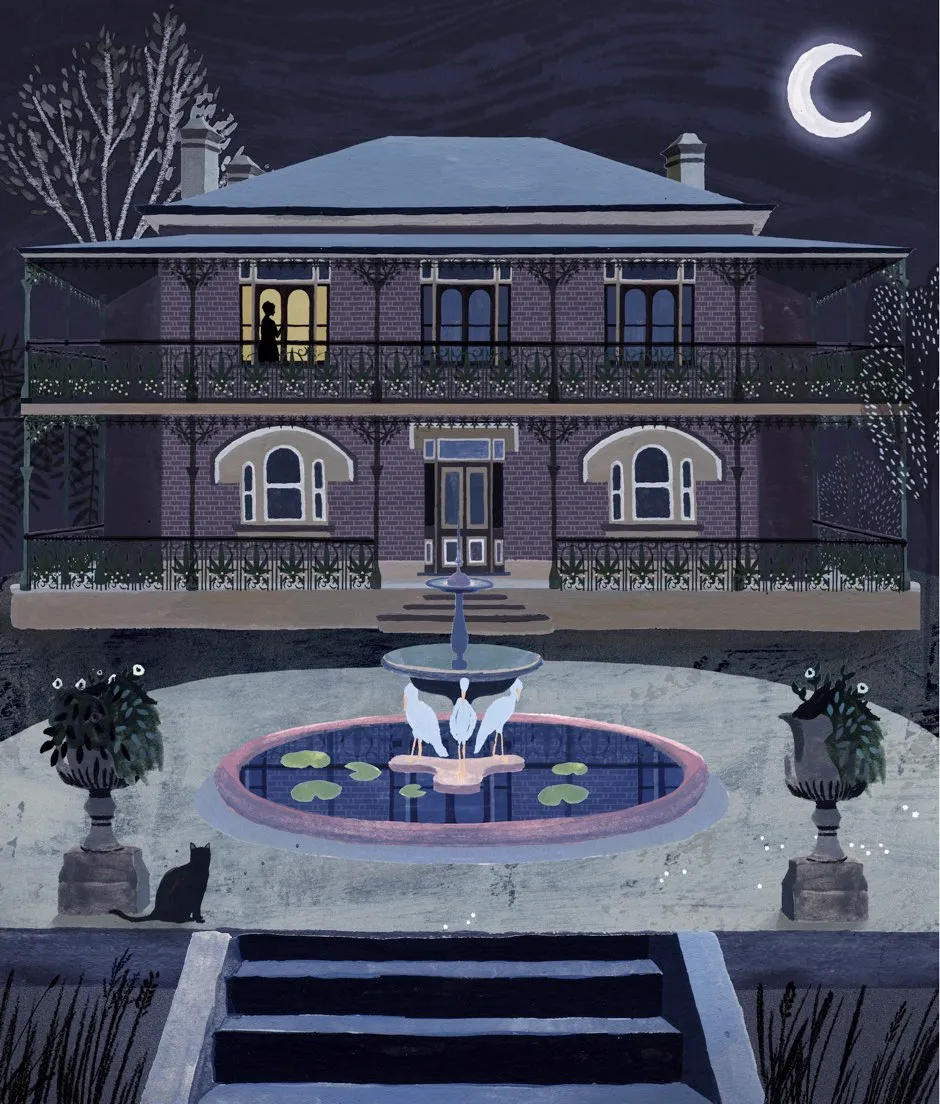The Monte Cristo Homestead was once grand and new. But it has fallen into ruin after decades of neglect. Vandals stripped lead from the roof and broke all the windows. Squatters pulled up floorboards and burned them in the fireplace.
In 1963, Olive and Reginald Ryan purchase the run-down mansion in Junee, Australia and begin to repair it. Late one evening, after a shopping trip to pick up building supplies, they return home to an astonishing sight. Bright light streams from every door and window. That seems impossible. The house has no electricity! The Ryans think burglars are inside. Or maybe squatters returned. They tell their kids to stay in the car. Then, as they approach to investigate, the lights vanish. They find no one inside.
This is only the first of many unnerving experiences for the Ryans and their five children. They regularly hear footsteps walking across an upstairs balcony, and sometimes see a woman in white standing there. Olive feels hands resting on her shoulders when no one is there.
Reginald hangs a picture, then finds it fallen on the floor but unbroken, two nights in a row. And in the most disturbing incident of all, one evening one of their daughters goes to check on her sleeping little brother, and sees an elderly man in old-fashioned clothes standing at the end of his bed.
They regularly hear footsteps walking across an upstairs balcony.
She races off, screaming to her family about a man in the house. But they find no one. The little brother, Lawrence Ryan, learns about this incident as a teenager, then moves out of the main house to a different bedroom. He says, “I always felt like someone was watching me in that room.” Was that someone a ghost?

Christopher William Crawley, the wealthy and powerful founder of the town of Junee, once lived in the mansion with his wife, children and numerous servants. The family hosted fancy balls and played tennis and golf in the grounds. Crawley died in the home at the age of 69 after a boil on his neck got infected. After his death, the locals say, his wife almost never left the house. She died there at the age of 92.
But the property’s creepy history began long before their deaths. According to local lore, a young maid fell from the balcony to her death. She was rumoured to be pregnant at the time, and some believe she was killed to cover up that fact. Could she be the source of the footsteps and female figure on the balcony?
I always felt like someone was watching me in that room.
Another servant, a stableboy, supposedly suffered lethal burns when his straw mattress was set on fire. The Crawleys’ youngest child, a baby daughter named Magdalena, died in a fall down the stairs. Some think her nanny may have dropped her on purpose. Could the spirits of all of these people still haunt the place where they died?

A menagerie of spirits
If you believe in ghosts, you’re not alone. A 2017 poll found that around half of Americans believe that places can be haunted by spirits. Polls in many other countries around the world produce similar results. Belief in ghosts depends on what you think happens after death. The physical body perishes, but what happens to your consciousness? Are you gone forever?
Many people believe in a soul or something similar that survives past death.
Or do you continue to experience this world or another world in some way? Many people believe in a soul or something similar that survives past death. It’s not a huge step from the idea of an afterlife to the belief that spirits may influence the world of the living. However, people from different cultures tell very different stories about how and why ghosts appear.
In ancient Mesopotamia, people believed that sickness was a punishment inflicted by spirits of the dead. In Mexico and parts of Central America, everyone knows the legend of La Llorona, the weeping woman. In one version of the story, she drowned her own children, and now haunts riverbanks, calling and crying for them. In China and parts of Southeast Asia today, many people ask the spirits of their ancestors for blessings. During the Hungry Ghost Festival, people in this region burn paper or incense and leave out gifts, food, tea and sweets. They believe that these offerings will please the ghosts and help prevent bad luck.

Ghost stories can be fascinating, scary and memorable. But they are just stories. Only physical evidence could show that ghosts are real. People who call themselves ghost hunters or paranormal investigators search for this evidence. Some claim to have found it.
Hunting for phantoms
Ghost hunters often arm themselves with a variety of high-tech equipment, including cameras and audio recorders as well as instruments that measure temperature (ghosts supposedly create cold spots) or detect motion. Electromagnetic field (EMF) meters are especially popular.
Cameras may capture still images or videos that show shadowy figures, glowing wisps, or orbs of light.
Electromagnetic energy comes in a wide spectrum that includes everything from high-energy X-rays to low-energy radio waves. Visible light falls in the middle of the spectrum. Electricians use EMF meters to detect the energy that electrical wires and devices emit, which is in the radio frequency range. This energy is strongest right next to the source, but weakens rapidly with distance. When EMF readers detect fluctuations, or rising and falling amounts of electromagnetic energy, some think this indicates a ghostly presence.
Audio equipment may record what seem to be faint voices saying short phrases, like “Get out.”
Investigators set up their equipment in a haunted location and wait. Often, they find nothing. But occasionally, they record something unusual. Cameras may capture still images or videos that show shadowy figures, glowing wisps or orbs of light. Audio equipment may record what seem to be faint voices saying short phrases, like “Get out.” This is called Electronic Voice Phenomenon, or EVP for short. An EMF meter may fluctuate wildly, indicating a source of energy. These recordings seem intriguing. But are they really evidence of ghosts?

Spooky faces and murmuring voices
Photos and audio anomalies may seem like convincing evidence. But it’s a mistake to jump directly to a supernatural explanation for a strange photo or recording. First, you have to consider all possible practical explanations. Remember the principle of Occam’s Razor? Simple explanations that make the fewest possible assumptions are always the most likely to be true. When it comes to photographs, many things other than ghosts can explain haunting images.

In the 1860s, photographer William H. Mumler captured images that seemed to show deceased relatives hovering over living family members. His most famous image shows a ghostly Abraham Lincoln with his hands on the shoulders of his widow, Mary Todd Lincoln. The photo was taken a few years after the American president’s assassination.
During the mid to late 19th century in America, many people who called themselves spiritualists believed that the dead could communicate with the living. Special ceremonies called seances were held in an attempt to talk to the dead. People also used ouija boards, which look like game boards covered in letters and numbers, to channel what seemed to be messages from spirits.
Many people believed that the dead could communicate with the living.
Spiritualists believed that Mumler’s photos were the real deal, but others accused him of fraud. In very early cameras, a sensitive glass plate captured the image. If this plate was not cleaned well enough, a faint image from a previous photograph might show up in the background of a new photo. Mumler later admitted that one of his first ghost photos happened accidentally when he forgot to clean a plate. Others were likely deliberate hoaxes.

Many modern ghost images are also the result of mistakes, technical glitches or deliberate hoaxes. If a person moves quickly past a camera while a photo is being taken, for example, the image may show a blurry streak. Flash photographs often capture mysterious orbs of light. Some call these spirit energy. More likely, the flash reflected off dust or water droplets on or near the lens.
Some ghost images are not technical glitches but psychological ones. For example, a photo from the Monte Cristo homestead seems to show the baby Magdalena’s face in a mirror. Most likely, it is not a face at all, but a random reflection that happens to resemble a face.
So sometimes the brain finds faces where there are none.
To experience this for yourself, take a look at the moon the next time it’s full. Do you see a face? Many people do. People also regularly see familiar shapes in clouds. This phenomenon is called pareidolia. It happens because it’s very important for the brain to identify familiar patterns, like faces. So sometimes the brain finds faces where there are none.
Similarly, the brain may find words in static or random noise. This is the most likely explanation in many examples of EVP. In other cases, the audio equipment may have captured distant voices or music that were too faint for human ears to hear. Ghost hunting teaches the important lesson that using technical equipment does not make an investigation scientific.

Anomalies in data only seem like evidence of ghosts because that’s what ghost hunters are looking for. Noah Leigh has led the Paranormal Investigators of Milwaukee group for over ten years. When his group hunts for EVPs, they ask a question, then leave ten seconds of silence to allow for an answer. They use strict procedures to help rule out noise from growling stomachs, squeaky doors and other background sounds. He says, “In all our years doing this, we’ve never had a direct response to a question, ever.”
How to haunt a house
If a haunted location isn’t really home to wandering spirits of the dead, then why do so many people have strange experiences at a place like the Monte Cristo Homestead? What makes a house haunted? Scientists have proposed some intriguing theories. Some blame infrasound. These sounds are too low to hear, but the body feels their vibrations. In some people, these vibrations may cause feelings of uneasiness or fear. Others have studied how electromagnetic fields affect the brain.
In some people, these vibrations may cause feelings of uneasiness or fear.
In people with a certain form of epilepsy, a part of the brain called the temporal lobe malfunctions, causing visions that are often religious in nature. Some scientists have studied whether electromagnetic fields might trigger this same effect in people without epilepsy. The fields may come from natural sources, such as minor earthquakes or tremors. Or they might come from power lines, mobile phones, appliances and other devices.

However, experimentation has shed doubt on these theories. In 2004, psychologist Christopher French and his colleagues at Goldsmiths University of London attempted to create a haunted room. They set up and hid devices that would generate electromagnetic fields and infrasound. One by one, seventy-nine volunteers entered the room, a cool, dimly lit, empty, white, circular space, and stayed there for fifty minutes. The researchers told the volunteers they might have some unusual sensations and asked them to record any such experiences.
The researchers told the volunteers they might have some unusual sensations and asked them to record any such experiences.
Some volunteers got bombarded with electromagnetic fields and infrasound, others with one or the other, and a control group with nothing. But it didn’t matter which group a volunteer was in. People in the control group were just as likely to report weird sensations as people in the other groups. What was going on?
After everyone left the room, they all completed a personality test. Suggestible people – those who easily accept what others tell them to do or believe – tend to get high scores on a certain part of the test. Everyone who reported strange experiences also got high scores on this part of the test. So they seem to have experienced strange things in the room not because of energy fields or vibrations, but because the researchers told them they would. In other words, people experience strange things in haunted houses because they’re expecting strange things to happen.

Alternately, someone who experiences strange things may turn to ghosts as a fitting explanation. This is similar to what happens in many alien and UFO experiences. The things people see are created in the brain and do not always represent reality. A hallucination, vivid dream or even a trick of the light may seem like a real encounter with a ghost.
Real-world experience
So what about the Monte Cristo Homestead? Today, Lawrence Ryan leads ghost tours there. But we may never know what really happened in the haunted mansion. Some of the tragic deaths may not actually have occurred, or may not have been murders. It’s often impossible to go back and find out the truth about events that happened many years ago. Even if murders did occur, these stories likely only serve to make visitors more uneasy and primed for unusual experiences.

Joe Nickell is a detective who has spent his entire career looking for realistic explanations for events that seem paranormal. “It doesn’t matter what you and I believe,” he says. “It matters what we have evidence for.” He has investigated many reportedly haunted places. In one of his first cases, he discovered that the footsteps people heard on a haunted staircase came from a very real iron staircase located in the building next door.
If you come to our place you can make up your own mind.
Similarly, the strange light inside the Monte Cristo homestead could have come from people in the house, just as the Ryans first suspected. If squatters were in the house, they likely knew they weren’t supposed to be there and fled when they saw the car. Just because the Ryans never figured out a real-world source of the light, the footsteps, the figure on the balcony, the man in the bedroom or other strange events does not mean that there wasn’t one.
Lawrence Ryan is inclined to believe in ghosts after his experience growing up at the Monte Cristo Homestead. But he doesn’t push anything on his guests. “If you come to our place you can make up your own mind,” he says.
Strange but True: 10 of the world's greatest mysteries explained by Kathryn Hulick and illustrated by Gordy Wright is available now (£14.99, Quarto Publishing Plc)
